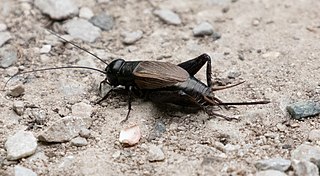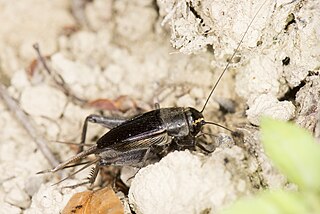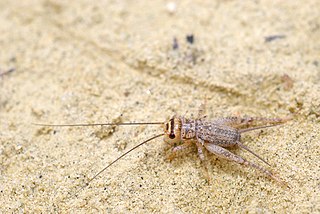
Gryllinae, or field crickets, are a subfamily of insects in the order Orthoptera and the family Gryllidae.
Elsa Salazar Cade is a Mexican-American science teacher and entomologist.
Dr. William H. "Bill" Cade is a biologist and a former president of the University of Lethbridge. He researches the role of acoustic signals in field cricket mating behaviour.

Ormia ochracea is a small yellow nocturnal fly in the family Tachinidae. It is notable for its parasitism of crickets and its exceptionally acute directional hearing. The female is attracted to the song of the male cricket and deposits larvae on or around him, as was discovered in 1975 by the zoologist William H. Cade.

Gryllus pennsylvanicus is known as the fall field cricket. G. pennsylvanicus is common in southern Ontario, is widespread across much of North America and can be found even into parts of northern Mexico. It tends to be absent in most of the southwestern United States including southern California. Within its geographic range this field cricket will burrow into soil in fields and forest edges. Individuals inhabit grassy disturbed areas and are often found around areas of human habitation.

Gryllus veletis, commonly known as the spring field cricket, is abundant throughout eastern North America. G. veletis is a solitary, aggressive, omnivorous, burrow-inhabiting species of cricket. This species is commonly confused with Gryllus pennsylvanicus, as they inhabit the same geographical area. However, the two species are easily distinguished through examination of life history, ovipositor and behavioural differences. Predators of G. veletis include American toads, wild turkeys, red-tailed hawks, wolf spiders and red-backed salamanders.

Gryllus is a genus of field cricket. Members of the genus are typically 15–31 mm long and darkly coloured. The type species is Gryllus campestris L.: the European field cricket.
Platygryllus is a genus of crickets in the subfamily Gryllinae. Records of species distribution include Africa, southern Europe and in Asia: India, Java and the Philippines.

Teleogryllus is a genus of crickets in the family Gryllidae. Species can be found in Africa, Asia, Australia and the Pacific islands.

Gryllus rubens, commonly known as the southeastern field cricket, is one of many cricket species known as a field cricket. It occurs throughout most of the Southeastern United States. Its northern range spans from southern Delaware to the extreme southeastern corner of Kansas, with a southern range stretching from Florida to eastern Texas.

Gryllus bryanti is a species of cricket in the subfamily Gryllinae. G. bryanti lives on islands in the Caribbean Sea, including Eleuthera Island and Andros Island in the Bahamas.
Gryllus integer, commonly known as the western trilling cricket, is one of many species of field cricket in the genus Gryllus. It is called the "triller" field cricket because its song is nearly continuous rather than broken into discrete chirps. G. integer can be found in parts of the Western United States, having been recorded from Oregon, California, Arizona and New Mexico.
Gryllus firmus, commonly known as the sand field cricket, is a species of cricket in the subfamily Gryllinae. It is found in the southeastern United States.

Gymnogryllus is a genus of crickets in family Gryllidae and tribe Gryllini. Species are recorded from Africa, Asia and Australia.
Pseudomogoplistes is a genus of crickets in the family Mogoplistidae, erected by AV Gorochov in 1984. The recorded distribution of species is Europe and North Africa.
Gryllus brevicaudus, the short-tailed field cricket, is a species of cricket in the subfamily Gryllinae.. It is found in North America.

Gryllini is a tribe of crickets and typical of the family Gryllidae. Species are terrestrial, carnivorous or omnivorous and can be found in all continenents except Antarctica.

Modicogryllus is the type genus of crickets in the tribe Modicogryllini. Species have been recorded from: Europe, Africa, the middle East, temperate and tropical Asia through to Australia and western Pacific islands.

Svercus palmetorum is a small species of cricket, and the sole member of the genus Svercus.












